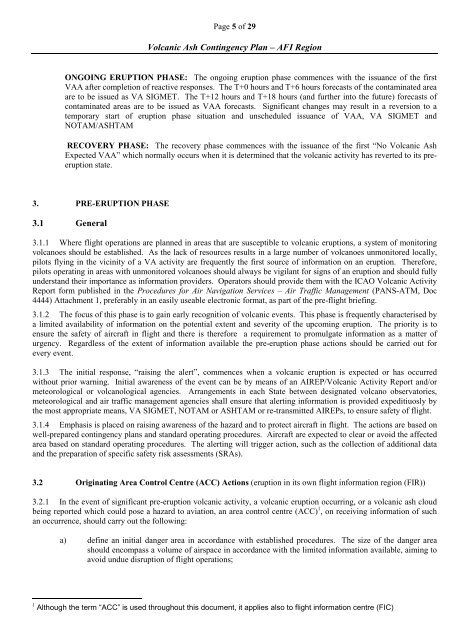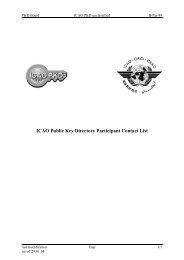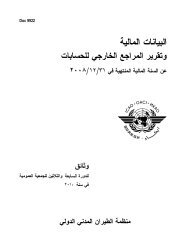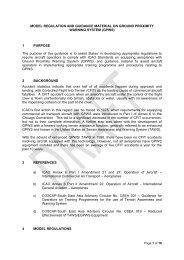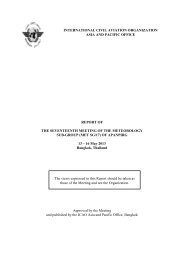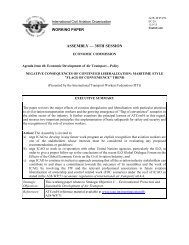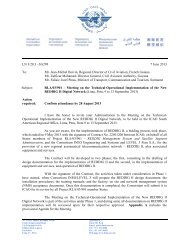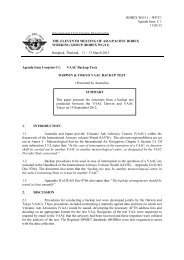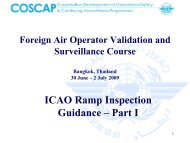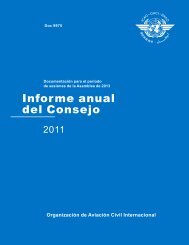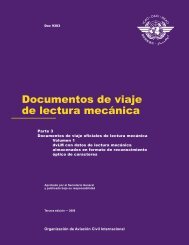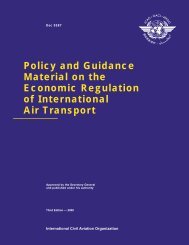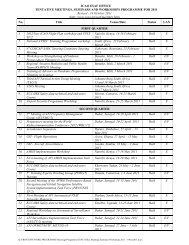afi met bulletins exchange (ambex) handbook - ICAO
afi met bulletins exchange (ambex) handbook - ICAO
afi met bulletins exchange (ambex) handbook - ICAO
Create successful ePaper yourself
Turn your PDF publications into a flip-book with our unique Google optimized e-Paper software.
Page 5 of 29<br />
Volcanic Ash Contingency Plan – AFI Region<br />
ONGOING ERUPTION PHASE: The ongoing eruption phase commences with the issuance of the first<br />
VAA after completion of reactive responses. The T+0 hours and T+6 hours forecasts of the contaminated area<br />
are to be issued as VA SIGMET. The T+12 hours and T+18 hours (and further into the future) forecasts of<br />
contaminated areas are to be issued as VAA forecasts. Significant changes may result in a reversion to a<br />
temporary start of eruption phase situation and unscheduled issuance of VAA, VA SIGMET and<br />
NOTAM/ASHTAM<br />
RECOVERY PHASE: The recovery phase commences with the issuance of the first “No Volcanic Ash<br />
Expected VAA” which normally occurs when it is determined that the volcanic activity has reverted to its preeruption<br />
state.<br />
3. PRE-ERUPTION PHASE<br />
3.1 General<br />
3.1.1 Where flight operations are planned in areas that are susceptible to volcanic eruptions, a system of monitoring<br />
volcanoes should be established. As the lack of resources results in a large number of volcanoes unmonitored locally,<br />
pilots flying in the vicinity of a VA activity are frequently the first source of information on an eruption. Therefore,<br />
pilots operating in areas with unmonitored volcanoes should always be vigilant for signs of an eruption and should fully<br />
understand their importance as information providers. Operators should provide them with the <strong>ICAO</strong> Volcanic Activity<br />
Report form published in the Procedures for Air Navigation Services – Air Traffic Management (PANS-ATM, Doc<br />
4444) Attachment 1, preferably in an easily useable electronic format, as part of the pre-flight briefing.<br />
3.1.2 The focus of this phase is to gain early recognition of volcanic events. This phase is frequently characterised by<br />
a limited availability of information on the potential extent and severity of the upcoming eruption. The priority is to<br />
ensure the safety of aircraft in flight and there is therefore a requirement to promulgate information as a matter of<br />
urgency. Regardless of the extent of information available the pre-eruption phase actions should be carried out for<br />
every event.<br />
3.1.3 The initial response, “raising the alert”, commences when a volcanic eruption is expected or has occurred<br />
without prior warning. Initial awareness of the event can be by means of an AIREP/Volcanic Activity Report and/or<br />
<strong>met</strong>eorological or volcanological agencies. Arrangements in each State between designated volcano observatories,<br />
<strong>met</strong>eorological and air traffic management agencies shall ensure that alerting information is provided expeditiuosly by<br />
the most appropriate means, VA SIGMET, NOTAM or ASHTAM or re-transmitted AIREPs, to ensure safety of flight.<br />
3.1.4 Emphasis is placed on raising awareness of the hazard and to protect aircraft in flight. The actions are based on<br />
well-prepared contingency plans and standard operating procedures. Aircraft are expected to clear or avoid the affected<br />
area based on standard operating procedures. The alerting will trigger action, such as the collection of additional data<br />
and the preparation of specific safety risk assessments (SRAs).<br />
3.2 Originating Area Control Centre (ACC) Actions (eruption in its own flight information region (FIR))<br />
3.2.1 In the event of significant pre-eruption volcanic activity, a volcanic eruption occurring, or a volcanic ash cloud<br />
being reported which could pose a hazard to aviation, an area control centre (ACC) 1 , on receiving information of such<br />
an occurrence, should carry out the following:<br />
a) define an initial danger area in accordance with established procedures. The size of the danger area<br />
should encompass a volume of airspace in accordance with the limited information available, aiming to<br />
avoid undue disruption of flight operations;<br />
1 Although the term “ACC” is used throughout this document, it applies also to flight information centre (FIC)


